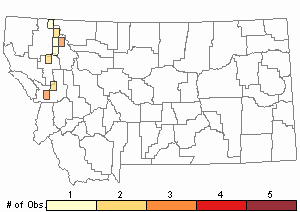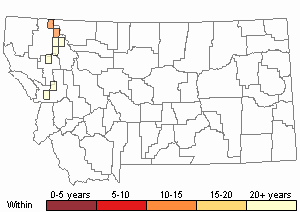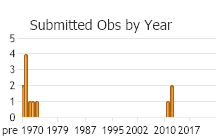View in other NatureServe Network Field Guides
NatureServe
Montana
Utah
Wyoming
Idaho
Wisconsin
British Columbia
South Carolina
Yukon
California
New York
Cordilleran Forestfly - Zapada cordillera
State Rank Reason (see State Rank above)
The Cordilleran stonefly is currently ranked "S2" in Montana because it is thought to be at risk due to very limited and/or potentially declining population numbers, range and/or habitat, making it vulnerable to extirpation in the state. Occurrences in the Northern Rocky Mountain region (Montana and Idaho) appear to be disjunct glacial refugium populations (Gustafson 2001).
General Description
We do not yet have descriptive information on this species. Please try the buttons above to search for information from other sources.
Diagnostic Characteristics
Adult morphology is described in Baumann et al. (1977) (see photo). Larvae have not been associated with the adults or distinguished from other Z. oregonensis group species, thus larvae would be identified to the species group level by taxonomy labs identifying bioassesment samples.
Species Range
Montana Range
Range Descriptions

 Native
Native
Range Comments
Rangewide, Zapada cordillera is known from scattered localities in California, Oregon, Washington, Idaho and Montana (Baumann et al. 1977, NatureServe 2015). Occurrences in the Northern Rocky Mountain region (Montana and Idaho) appear to be disjunct glacial refugium populations (Gustafson 2001). In Idaho, Z. cordillera has only been reported from Sherman Creek in Idaho County (Baumann et al. 1977). In Montana, Z. cordillera has been reported from scattered localities in Flathead and Glacier Counties, and from the Northern Rocky Mountain Refugium area of Mineral and Missoula Counties in west-central Montana (Baumann et al. 1977, Stagliano, unpublished data).
Observations in Montana Natural Heritage Program Database
Number of Observations: 15
(Click on the following maps and charts to see full sized version)
Map Help and Descriptions
Relative Density

Recency



 (Observations spanning multiple months or years are excluded from time charts)
(Observations spanning multiple months or years are excluded from time charts)
Habitat
This species occurs in spring-influenced creeks and small streams (Baumann et al. 1977; NatureServe 2015). The morphology of the mouthparts suggests that Zapada cordillera is well-suited for shredding plant materials, thus trophic relationships would include being shredders and collectors-gatherers (detritus, CPOM) (Merritt and Cummins 1996).
Food Habits
Merritt and Cummins (1996) report that members of this family are trophically shredder-detritivores; eating large particulate organic materials such as detritus, leaves and plants.
Reproductive Characteristics
In Montana, the adults emerge from March to May (Baumann et al. 1977).
Management
Zapada cordillera has been described as a rare species due to habitat specificity (Baumann et al. 1977) and is never abundant when collected. It has no USFWS status at the present time, although it has been proposed to be US Forest Service Sensitive Species in 2007; it is ranked globally uncommon (G3) by NatureServe (2015), listed as imperiled in Idaho (S1) and threatened (S2) in Montana.
Stewardship Responsibility
References
- Literature Cited AboveLegend:
 View Online Publication
View Online Publication Baumann, R.W, A.R. Gaufin, and R.F. Surdick. 1977. The stoneflies (Plecoptera) of the Rocky Mountains. American Entomological Society, Philadelphia.
Baumann, R.W, A.R. Gaufin, and R.F. Surdick. 1977. The stoneflies (Plecoptera) of the Rocky Mountains. American Entomological Society, Philadelphia. Merritt, R.W. and K.W. Cummins. 1996. An introduction to the aquatic insects of North America. 3rd Edition. Kendall/Hunt Publishing Company. Dubuque, Iowa. 862 pp.
Merritt, R.W. and K.W. Cummins. 1996. An introduction to the aquatic insects of North America. 3rd Edition. Kendall/Hunt Publishing Company. Dubuque, Iowa. 862 pp.
- Additional ReferencesLegend:
 View Online Publication
View Online Publication
Do you know of a citation we're missing? Gaufin, A.R., W.E. Ricker, M. Miner, P. Milam, and R.A. Hays. 1972. 'The Stoneflies (Plecoptera) of Montana'. Transactions of the American Entomological Society. 98 (1): 1-161.
Gaufin, A.R., W.E. Ricker, M. Miner, P. Milam, and R.A. Hays. 1972. 'The Stoneflies (Plecoptera) of Montana'. Transactions of the American Entomological Society. 98 (1): 1-161.
- Web Search Engines for Articles on "Cordilleran Forestfly"
- Additional Sources of Information Related to "Insects"





